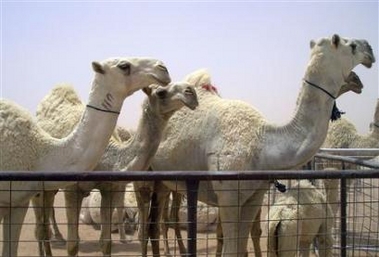Camel beauty pageant held
(Reuters)Updated: 2007-04-29 16:27
GUWEI'IYYA, Saudi Arabia - The legs are long, the eyes are big, the bodies curvaceous.
 Camels are displayed during the Mazayen al-Ibl competition, a parade of the 'most beautiful camels', in the desert region of Guwei'iyya, 120 km (75 miles) west of Riyadh April 25, 2007. [Reuters]  |
This week, the Qahtani tribe of western Saudi Arabia has been welcoming entrants to its Mazayen al-Ibl competition, a parade of the "most beautiful camels" in the desolate desert region of Guwei'iyya, 120 km (75 miles) west of Riyadh.
"In Lebanon they have Miss Lebanon," jokes Walid, moderator of the competition's Web site. "Here we have Miss Camel."
While tremendous oil wealth has brought rapid modernization to the desert state of Saudi Arabia, the camel remains celebrated as a symbol of the traditional nomadic lifestyle of Bedouin Arabs.
Throughout history camels have served multiple purposes as food, friend, transport and war machine. They were key to the Arab conquests of the Middle East and North Africa nearly 1,400 years ago that brought Islam to the world.
Camels are also big business in a country where strict Islamic laws and tribal customs would make it impossible for women to take part in their own beauty contest.
Delicate females or strapping males who attract the right attention during this week's show could sell for a million or more riyals. Sponsors have provided 10 million riyals ($2.7 million) for the contest, cash that also covers the 72 sports utility vehicles to be will be awarded as prizes.
"Bedouin Arabs are intimately connected to camels and they want to preserve this heritage. The importance of this competition is that it helps preserve the pure-breds," said Sheikh Omair, one of the tribe's leaders,
"We have more than 250 owners taking part and more than 1,500 camels," he said inside a huge tent where the final awards ceremony takes place.
RESTLESS BEAUTY QUEENS
Over at the camel pen, the contestants are getting restless as the desert wind howls and whips up swirls of sand in the hot afternoon sun.
Amid a large crowd of Bedouin who have gathered to watch, the head of the judging committee emerges to venture into an enclosure with some two dozen angry braying camels.
Camel-drivers sing songs of praise to their prized possessions as they try to calm the animals down.
"Beautiful, beautiful!" the judge mutters quietly to himself, inspecting the group. Finalists have been decorated with silver bands and body covers.
"The nose should be long and droop down, that's more beautiful," explains Sultan al-Qahtani, one of the organizers. "The ears should stand back, and the neck should be long. The hump should be high, but slightly to the back."
The camels are divided into four categories according to breed - the black majaheem, white maghateer, dark brown shi'l and the sufur, which are beige with black shoulders. Arabic famously has over 40 terms for different types of camel.
Some females have harnesses strapped around their genitalia to thwart any efforts by the males to mount them. One repeat offender called Marjaa has been moved away.
"This one would fetch a million!" says Hamad al-Sudani, a camel-driver, admiring the heavy stud, or fahl.
|
||
|
|